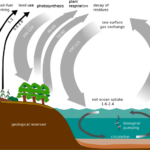Ecosystem Dynamics
Succession in an ecosystem is the natural process of change and development over time, where different species gradually establish and shape the environment.
- Primary Succession: Life begins in areas with no previous ecosystem, like new volcanic islands or land uncovered by melting glaciers.
- Secondary Succession: An ecosystem regrows after a disturbance, such as a wildfire or a flood, as plants and animals return and restore balance.
Keystone Species: These species have a huge impact on their ecosystem. For example, wolves in Yellowstone help control deer populations, which supports vegetation growth and the animals that rely on those plants.
Energy Flow & Nutrient Cycles
Energy and nutrients move through ecosystems in cycles, supporting life and connecting all organisms in a web of interactions.
Energy Flow:
- Photosynthesis: Plants (producers) use sunlight to create energy, forming the base of the food web.
- Food Chains and Webs: Energy moves from plants to herbivores, carnivores, and decomposers in connected food chains and webs.
Nutrient Cycles:
- Water Cycle: Water moves through ecosystems as it evaporates, condenses, and returns as precipitation.
- Carbon and Nitrogen Cycles: Carbon and nitrogen are cycled between air, soil, plants, and animals, supporting growth and energy.
Ecosystem Recovery
Natural events and human activities can disrupt ecosystems, but they have remarkable ways of recovering and rebuilding.
Natural Disturbances: Events like wildfires, floods, and storms can damage ecosystems and create opportunities for new growth.
Human Impact: Activities like deforestation, pollution, and climate change can harm ecosystems by destroying habitats and upsetting natural cycles.
Recovery Process:
- Resilience and Succession: Many ecosystems bounce back over time through primary or secondary succession, gradually restoring balance.
- Conservation Efforts: Reforestation, pollution control, and protected areas help support ecosystem recovery.
Fun Facts
Here are some interesting facts about ecosystems:
- Rainforest canopies are like mini-ecosystems with unique species of insects, birds, and plants that rarely touch the ground.
- The ocean is the largest ecosystem, covering about 70% of the Earth’s surface and supporting an incredible diversity of life.
- Polar ecosystems support entire food chains. Animals like polar bears and penguins thrive in extreme cold, while tiny algae survive on ice and snow.
Review
Let’s quickly recap what we learned about ecosystems:
- What type of succession occurs on new land, like a lava field? Primary Succession
- What type of species has a large impact on its ecosystem? Keystone Species
- What do interconnected feeding relationships in ecosystems form? Food Webs
- To support growth, which elements are cycled between air, soil, plants, and animals? Carbon & Nitrogen


Recent Comments